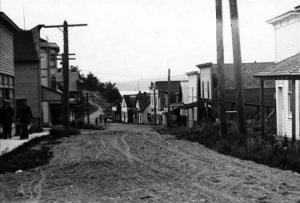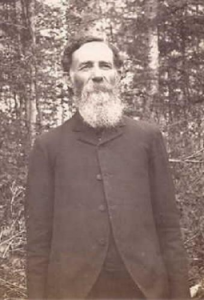A Young Woman in Washington State Upholds the Legacy of Union Army Veterans in 1914
ECW welcomes back guest author Richard Heisler

Ester Boyer was a schoolgirl just 15 years of age living in Washington State in 1914. Miss Boyer lived a bit northwest of Seattle in the small town of Coupeville, on Whidbey Island. She had been born and raised there in the presence of her grandfathers, Civil War veterans Lawrence Boyer of the 177th Pennsylvania Infantry and Samuel Clark Black of the 151st Illinois Infantry. Despite being several decades and thousands of miles removed from the scene of the great national conflict of the 1860’s, Ester was sympathetic to the legacy of the Civil War and the veterans she’d grown up surrounded by.
A widely circulated Seattle newspaper of the time, the Seattle Star, featured a section on Saturdays titled the “Star Circle For Young Folks”. The “Circle” contained stories and news of interest to the region’s younger readers and typically included a writing contest on topics such as gardening or sports. Children aged 16 and under from around the Puget Sound, known as “Circleites”, submitted their entries each week. The winners were awarded a silver dollar.

On May 23, 1914, the contest topic of the week was simply “Memorial Day”. The Circleites were to “Tell why Memorial Day is observed and why every boy and girl should take part in the tribute paid the soldier dead that day.” More than 100 entries flooded in. “The Star boys and girls seemed eager to take part in this contest. Many pretty tributes were paid the memory of the soldiers who died for the flag,” commented the Star. Ester Boyer’s submission was chosen as the winner. She wrote:
Memorial Day is a day set aside for decorating the soldiers’ graves. The custom originated in the South, during the Civil War, when women and children gathered wild flowers to decorate the graves of the soldiers. It was also kept by individuals in the North. In 1868, General Logan, then commander-in-chief of the army, fixed May 30 as a day on which all soldiers should strew flowers over the graves of their comrades. Although there has been no law passed, it is considered a legal holiday by most states. Usually the day’s program includes processions and orations. Many people think this is the most beautiful of all our holidays.
In addition to Miss Boyer, several honorable mentions were given. Among them were other grandchildren of Union Army veterans including Ruby Fowler of Ballard, whose grandfather had been killed in action at Petersburg as a member of the 38th Wisconsin Infantry. These young folks had a unique understanding of the meaning and origins of Memorial Day. The topic of the next Star contest on June 14 was more challenging but Esther was again well prepared for it.

The Circleites were asked to write about a proposal that was then before Congress to alter the design of the United States flag. The concept was “that the bars of the old Confederate flag be arranged in the field of stars in the form of the Southern cross, just as the flag of England embraces the ancient flags of England, Ireland and Scotland.” The thought of adding the Confederate “stars and bars” to the United States flag rankled Union Army veterans in every corner of the country, but what did the young folks of Puget Sound think? Esther Boyer faced this complicated subject admirably. The Star again selected her effort as its top choice and commented that “her winning essay is exceptionally good and was picked out from among the 22 entrants.”
I say it should not be changed. It has grown in the heart of every American, with its 48 stars in a field of blue and stripes of red and white. The birth of our flag occurred on June 14, 1777. It was then Congress passed a resolution that the flag have 13 stripes and 13 stars. With the addition of another state into the Union another star should be added. If it is, as we suppose, that the Southern states have realized their mistake, will it not be a humiliation to be constantly reminded of the disloyalty? Would it not be like rewarding a child for disobedience? Will the old war veterans ever feel the love for the new flag they felt for the old? I say they will not. Then why change it? What good can it possibly do?
The words of Esther Boyer resonate with the legacy of both of her grandfathers and all veterans of the Union Army. The Star was correct, her short essay was “exceptionally good”. It showcased the astute mind of a bright young woman who was raised with a sensitivity and understanding of what her grandfathers and their comrades had struggled for during the Civil War.

Sadly, Esther Boyer passed away in 1922 at the young age of 23. She is buried near her grandfathers in Coupeville’s Sunnyside cemetery.


_____________
Sources:
“Memorial Day is topic of weekly Circle contest” Seattle Star. May 23, 1914.
https://washingtondigitalnewspapers.org/ (accessed July 15, 2021)
“Prize Winning Essay” Seattle Star. May 30, 1914. https://washingtondigitalnewspapers.org/ (accessed July 15, 2021)
“What do you think, boys and girls, of the plan to change the American flag?” Seattle Star. June 13, 1914. https://washingtondigitalnewspapers.org/ (accessed July 15, 2021)
“Shall the design of Old Glory be changed? Here’s what Circleites say” Seattle Star. June 20, 1914. https://washingtondigitalnewspapers.org/ (accessed July 15, 2021)
U.S. Census Bureau, 12th Census of the United States 1900. www.familysearch.com (accessed July 15th, 2021)
U.S. Census Bureau, 11th Census of the United States 1890 Special Schedule Surviving Soldiers, Sailors and Marines, and Widows Etc.. www.familysearch.com (accessed July 15th, 2021)
U.S. Census Bureau, 13th Census of the United States 1910. www.familysearch.com (accessed July 15th, 2021)
Esther Boyer. photograph. www.ancestry.com. uploaded by _sgrasser_
Lawrence Boyer. photograph. www.ancestry.com. uploaded by _baldwin541_ Samuel Clark Black. Photograph. www.ancestry.com. uploaded by _sgrasser_ Downtown Coupeville 1912. photograph. UW Special Collection PHColl 799
As a resident of Washington State I enjoyed this glimpse into history. It became even more interesting when I noticed that the 1912 picture of Coupeville included a building where I enjoyed lunch a week ago tomorrow. I think a visit to Esther’s gravesite to pay my respects is in my future; besides it includes a relaxing ferry ride! I’m a descendant of soldiers on both sides of this tragic war.
Thanks for this emotional article. It’s nice to see those young vets lasted to be old Grampas. Sad that articulate Esther died so young, but she did her part to halt the abomination of the rebel arrangement of stars on their battle flag from being incorporated into the star field of Old Glory.
thanks Richard for the inspiring story about a great, young American.